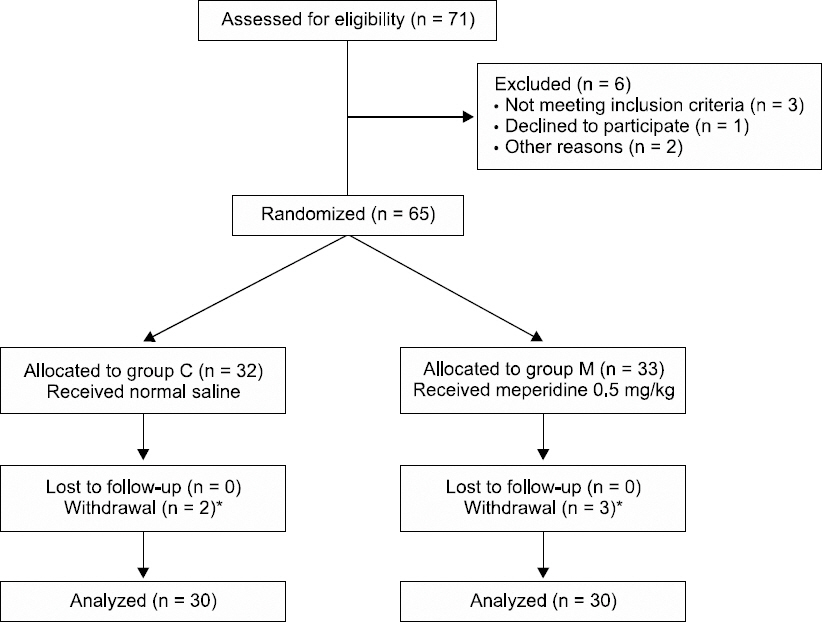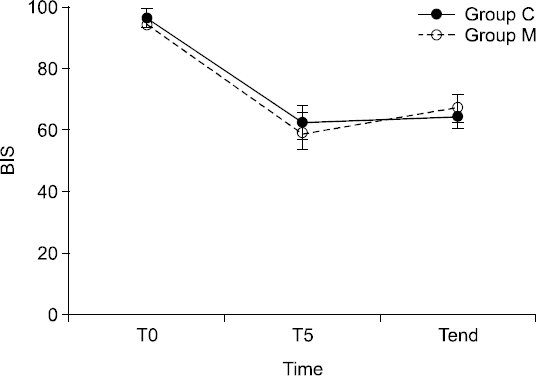Anesth Pain Med.
2017 Apr;12(2):123-131. 10.17085/apm.2017.12.2.123.
The effects of meperidine in patients undergoing deep sedation for transrectal ultrasound-guided prostate biopsy: a randomized, controlled, double-blind study
- Affiliations
-
- 1Department of Anesthesiology and Pain Medicine, St. Vincent's Hospital, College of Medicine, The Catholic University of Korea, Seoul, Korea. likewinds@catholic.ac.kr
- 2Department of Urology, St. Vincent's Hospital, College of Medicine, The Catholic University of Korea, Seoul, Korea.
- KMID: 2379731
- DOI: http://doi.org/10.17085/apm.2017.12.2.123
Abstract
- BACKGROUND
The transrectal ultrasound-guided prostate biopsy (TRUS-PBx) is one of the most common procedures among day care center based urologic procedures. Our aim was to determine if pretreatment with meperidine could improve the quality of anesthesia in patients undergoing deep sedation for TRUS-PBx.
METHODS
Sixty male patients (30-80 years; American Society of Anesthesiologists physical status class I or II) scheduled for TRUS-PBx were allocated randomly into two groups. After pretreatment with normal saline (Group C) or intravenous (i.v.) meperidine 0.5 mg/kg (Group M), sedation was induced with i.v. propofol 1.5 mg/kg. Additional doses of i.v. propofol 0.5 mg/kg were administered upon patient movement. During the procedure, hemodynamic variables, patient movement, and the bispectral index were measured. After the procedure, the mean modified observer's assessment of alertness/sedation score (MOASS), postprocedural pain, side effects, and patient satisfaction were evaluated.
RESULTS
During the procedure, patient movement was not significantly different between the two groups, but Group M required a significantly lower total propofol dose compared to that of Group C (P = 0.036). After the procedure, the MOASS was comparable between the two groups (P = 0.055), but Group M patients experienced significantly less postprocedural pain (P = 0.012), lower systolic and diastolic blood pressure at 45 (P = 0.044 and P = 0.014) and 60 minutes (P < 0.001 and P = 0.006), and lower incidence of tenesmus than Group C (P = 0.020).
CONCLUSIONS
Meperidine can be used as a safe, effective analgesic with deep sedation for patients undergoing TRUS-PBx.
Keyword
MeSH Terms
Figure
Reference
-
1. Halpern EJ, Strup SE. Using gray-scale and color and power Doppler sonography to detect prostatic cancer. AJR Am J Roentgenol. 2000; 174:623–7. DOI: 10.2214/ajr.174.3.1740623. PMID: 10701599.2. Autorino R, De Sio M, Di Lorenzo G, Damiano R, Perdonà S, Cindolo L, et al. How to decrease pain during transrectal ultrasound guided prostate biopsy:a look at the literature. J Urol. 2005; 174:2091–7. DOI: 10.1097/01.ju.0000181212.51025.06. PMID: 16280735.3. Hou CP, Lin YH, Hsieh MC, Chen CL, Chang PL, Huang YC, et al. Identifying the variables associated with pain during transrectal ultrasonography of the prostate. Patient Prefer Adherence. 2015; 9:1207–12. DOI: 10.1016/j.urols.2015.06.173.4. Lee C, Woo HH. Current methods of analgesia for transrectal ultrasonography (TRUS)-guided prostate biopsy -- a systematic review. BJU Int. 2014; 113(Suppl 2):48–56. DOI: 10.1111/bju.12433. PMID: 24053451.5. Maccagnano C, Scattoni V, Roscigno M, Raber M, Angiolilli D, Montorsi F, et al. Anaesthesia in transrectal prostate biopsy:which is the most effective technique? Urol Int. 2011; 87:1–13. DOI: 10.1159/000327827. PMID: 21677420.6. Awsare NS, Green JA, Aldwinckle B, Hanbury DC, Boustead GB, McNicholas TA. The use of propofol sedation for transrectal ultrasonography-guided prostate biopsy is associated with high patient satisfaction and acceptability. Eur J Radiol. 2007; 63:94–5. DOI: 10.1016/j.ejrad.2006.12.010. PMID: 17276645.7. Barbosa RA, da Silva CD, Torniziello MY, Cerri LM, Carmona MJ, Malbouisson LM. A comparative study among three techniques of general anesthesia for ultrasound-guided transrectal prostate biopsy. Rev Bras Anestesiol. 2010; 60:457–65. DOI: 10.1590/S0034-70942010000500002.8. Bozlu M, Atici S, Ulusoy E, Canpolat B, Cayan S, Akbay E, et al. Periprostatic lidocaine infiltration and/or synthetic opioid (meperidine or tramadol) administration have no analgesic benefit during prostate biopsy. A prospective randomized double-blind placebo-controlled study comparing different methods. Urol Int. 2004; 72:308–11. DOI: 10.1159/000077683. PMID: 15153728.9. Mildh LH, Leino KA, Kirvelä OA. Effects of tramadol and meperidine on respiration, plasma catecholamine concentrations, and hemodynamics. J Clin Anesth. 1999; 11:310–6. DOI: 10.1016/S0952-8180(99)00047-1.10. Davis M, Sofer M, Kim SS, Soloway MS. The procedure of transrectal ultrasound guided biopsy of the prostate:a survey of patient preparation and biopsy technique. J Urol. 2002; 167:566–70. DOI: 10.1016/S0022-5347(01)69087-6. PMID: 11792920.11. Seymour H, Perry MJ, Lee-Elliot C, Dundas D, Patel U. Pain after transrectal ultrasonography-guided prostate biopsy:the advantages of periprostatic local anaesthesia. BJU Int. 2001; 88:540–4. DOI: 10.1046/j.1464-410X.2001.02324.x. PMID: 11678747.12. Obek C, Onal B, Ozkan B, Onder AU, Yalçin V, Solok V. Is periprostatic local anesthesia for transrectal ultrasound guided prostate biopsy associated with increased infectious or hemorrhagic complications? A prospective randomized trial. J Urol. 2002; 168:558–61. DOI: 10.1016/S0022-5347(05)64679-4.13. Vaidya A, Soloway MS. Periprostatic local anesthesia before ultrasound-guided prostate biopsy:an update of the miami experience. Eur Urol. 2001; 40:135–8. DOI: 10.1159/000049763. PMID: 11528189.14. Turgut AT, Ergun E, Koşar U, Koşar P, Ozcan A. Sedation as an alternative method to lessen patient discomfort due to transrectal ultrasonography-guided prostate biopsy. Eur J Radiol. 2006; 57:148–53. DOI: 10.1016/j.ejrad.2005.08.001. PMID: 16159704.15. Shrimali P, Bhandari Y, Kharbanda S, Patil M, Srinivas V, Gaitonde S, et al. Transrectal ultrasound-guided prostatic biopsy:midazolam, the ideal analgesic. Urol Int. 2009; 83:333–6. DOI: 10.1159/000241678. PMID: 19829036.16. Park JY, Park SJ, Choi SU, Shin HW, Lee HW, Lim HJ, et al. Target-controlled propofol infusion for sedation in patients undergoing transrectal ultrasound-guided prostate biopsy. J Int Med Res. 2007; 35:773–80. DOI: 10.1177/147323000703500605. PMID: 18034990.17. Peters JL, Thompson AC, McNicholas TA, Hines JE, Hanbury DC, Boustead GB. Increased patient satisfaction from transrectal ultrasonography and biopsy under sedation. BJU Int. 2001; 87:827–30. DOI: 10.1046/j.1464-410x.2001.02221.x. PMID: 11412220.18. Kang SG, Tae BS, Min SH, Ko YH, Kang SH, Lee JG, et al. Efficacy and cost analysis of transrectal ultrasound-guided prostate biopsy under monitored anesthesia. Asian J Androl. 2011; 13:724–7. DOI: 10.1038/aja.2011.16. PMID: 21623389. PMCID: PMC3739578.19. Kaver I, Mabjeesh NJ, Matzkin H. Randomized prospective study of periprostatic local anesthesia during transrectal ultrasound-guided prostate biopsy. Urology. 2002; 59:405–8. DOI: 10.1016/S0090-4295(01)01538-2.20. Zisman A, Leibovici D, Kleinmann J, Siegel YI, Lindner A. The impact of prostate biopsy on patient well-being:a prospective study of pain, anxiety and erectile dysfunction. J Urol. 2001; 165:445–54. DOI: 10.1097/00005392-200102000-00023. PMID: 11176394.21. Nishikawa K, Yoshida S, Shimodate Y, Igarashi M, Namiki A. A comparison of spinal anesthesia with small-dose lidocaine and general anesthesia with fentanyl and propofol for ambulatory prostate biopsy procedures in elderly patients. J Clin Anesth. 2007; 19:25–9. DOI: 10.1016/j.jclinane.2006.05.017. PMID: 17321923.22. Lubarsky DA, Candiotti K, Harris E. Understanding modes of moderate sedation during gastrointestinal procedures:a current review of the literature. J Clin Anesth. 2007; 19:397–404. DOI: 10.1016/j.jclinane.2006.11.006. PMID: 17869995.23. Rosow C, Dershwitz M. Longnecker DE, Brown DL, Newman MF, Zapol WM, editors. Pharmacology of opioid analgesics. Anesthesiology. 2012. 2nd ed. New York: MacGraw-Hill;p. 703–16.24. Vuyk J, Sitsen E, Reekers M. Miller RD, editor. Intravenous anesthetics. Miller’s Anesthesia. 8th ed. Philadelphia: Elsevier;2015. p. 822–5.25. Xu N, Xue XY, Li XD, Wei Y, Lin N. Meperidine relieves pain during transrectal ultrasound-guided prostate biopsy. Saudi Med J. 2014; 35:454–9. PMID: 24825805.26. Luján Marco S, Bango García V, Arlandis Guzmán S, Di Capua Sacoto C, Bahílo Mateu P, Trassierra Villa M, et al. Comparative study between analgesic efficacy and safety of meperidine compared with lidocaine periprostatic infiltration in transrectal ultrasound guided prostate biopsy. Actas Urol Esp. 2009; 33:30–4. DOI: 10.1016/S0210-4806(09)73999-3.
- Full Text Links
- Actions
-
Cited
- CITED
-
- Close
- Share
- Similar articles
-
- Comparison of Two Local Anesthestic Methods for Transrectal Ultrasound Guided Prostate Biopsy: Periprostatic Injection of Lidocaine and Rectal Instillation of Lidocaine Gel
- Pain during Transrectal Ultrasound-Guided Prostate Biopsy and the Role of Periprostatic Nerve Block: What Radiologists Should Know
- Effect of Sedation Anesthesia With Intravenous Propofol on Transrectal Ultrasound-Guided Prostate Biopsy Outcomes
- Double-Blind Study of Intrarectal Administration of Anesthetic Agent for Pain Control during Transrectal Prostatic Biopsy
- Value and Safety of Midazolam Anesthesia during Transrectal Ultrasound-Guided Prostate Biopsy




